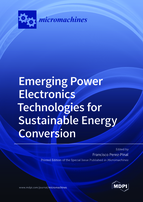Emerging Power Electronics Technologies for Sustainable Energy Conversion
A special issue of Micromachines (ISSN 2072-666X). This special issue belongs to the section "E:Engineering and Technology".
Deadline for manuscript submissions: closed (30 November 2021) | Viewed by 31829
Special Issue Editor
Interests: electronics; education; instrumentation and measurement; harvest energy
Special Issues, Collections and Topics in MDPI journals
Special Issue Information
Dear Colleagues,
Transforming, in a highly efficient way, energy from forms delivered by nature to forms that can be used by human beings for long-term sustenance is still an open challenge. To achieve this energy transformation, an appropriate design, control, and implementation of power electronic interfaces is usually required at each energy conversion stage.
Applications of needed sustainable energy conversion systems include but are not limited to smart connected and self-sustainable electronic grids; transportation electrification, e-mobility; healthcare and biomedicine; wearables; lighting; off-grid and rural electrification applications; and the Internet of Things and Everything, among others.
Therefore, to face such challenges, this Special Issue invites high-quality submissions with significant scientific and technical contributions related to the emerging technologies, techniques, and applications of power electronics to develop sustainable energy conversion systems. Topics of interest include but are not limited to the following:
- Power electronic technologies and techniques for sustainable energy conversion;
- Power electronics and renewable sustainable energy systems;
- Power electronics and energy storage systems;
- Power electronic interfaces for energy systems;
- Power electronics for harvest energy;
- Power electronic converters;
- Power electronics in pico-grids and micro-grids;
- Optimization in power electronics with applications to energy conversion;
- Intelligent power electronics in renewable energy systems;
- Electric/hybrid vehicle converters.
Prof. Dr. Francisco J. Perez-Pinal
Guest Editor
Manuscript Submission Information
Manuscripts should be submitted online at www.mdpi.com by registering and logging in to this website. Once you are registered, click here to go to the submission form. Manuscripts can be submitted until the deadline. All submissions that pass pre-check are peer-reviewed. Accepted papers will be published continuously in the journal (as soon as accepted) and will be listed together on the special issue website. Research articles, review articles as well as short communications are invited. For planned papers, a title and short abstract (about 100 words) can be sent to the Editorial Office for announcement on this website.
Submitted manuscripts should not have been published previously, nor be under consideration for publication elsewhere (except conference proceedings papers). All manuscripts are thoroughly refereed through a single-blind peer-review process. A guide for authors and other relevant information for submission of manuscripts is available on the Instructions for Authors page. Micromachines is an international peer-reviewed open access monthly journal published by MDPI.
Please visit the Instructions for Authors page before submitting a manuscript. The Article Processing Charge (APC) for publication in this open access journal is 2600 CHF (Swiss Francs). Submitted papers should be well formatted and use good English. Authors may use MDPI's English editing service prior to publication or during author revisions.
Keywords
- renewable energy sources
- harvest energy
- energy storage
- sustainable energy conversion
- power electronics converters
- modelling and control of power electronic converters
- (smart) pico and microgrids
- transportation electrification







